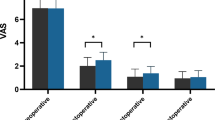Abstract
Purpose
The study aimed to determine the relationship between impulsivity and anxiety and recurrent metacarpal fractures (RMF) due to punching injury.
Methods
Consecutive 368 patients (301 men and 67 women) with metacarpal fracture who met the inclusion criteria and 214 healthy controls were included in the study. The study group was divided into two as the first metacarpal fracture (FMF) (245 patients) and RMF (123 patients). The control group consisted of sex- and age-matched 214 healthy participants (175 men and 39 women). Beck anxiety inventory (BAI), Barratt impulsiveness scale (BIS 11), and Quick DASH scores were the assessment of the patients in the sixth month of treatment. The groups were compared in terms of demographic features (including education status, marital status, work status, and level of income), fracture side, fracture location, dominant hand, treatment, anxiety, impulsivity, and functional results.
Results
In the RMF, BIS 11, BAI, and Quick DASH scores were significantly higher than the FMF and the healthy controls (p = 0.001 and p = 0.001, respectively). The patients with RMF have higher impulsivity and anxiety, worse short-term functional outcomes, and lower level of income and education status compared with healthy controls and FMF.
Conclusion
Anxiety and impulsivity are higher in patients with RMF. It adversely affects the clinical outcome after the treatment. Psychiatric consultation is an important step for especially intentional RMF patients to prevent recurrent hand injuries and metacarpal fractures and to improve clinical outcomes associated with these injuries.



Similar content being viewed by others
References
Adıyeke L, Aydogmus S, Sabuncuoğlu M, Bilgin E, Duymus TM (2019) Effects of psychological factors on the clinical outcomes of fifth metacarpal neck fractures and their relation to injury etiology. Ulus Travma Acil Cerrahi Derg 25(4):403–409. https://doi.org/10.5505/tjtes.2018.93928
Kural C, Alkaş L, Tüzün S, Çetinus E, Uğras AA, Alkaş M (2011) Anger scale and anger types of patients with fifth metacarpal neck fracture. Acta Orthop Traumatol Turc 45(5):312–315. https://doi.org/10.3944/AOTT.2011.2549
Trybus M, Tusinski M, Guzik P (2005) Alcohol-related hand injuries. Injury 36(10):1237–4120. https://doi.org/10.1016/j.injury.2004.09.003
Trybus M, Lorkowski J, Brongel L, Hladki W (2006) Causes and consequences of hand injuries. Am J Surg 192(1):52–57. https://doi.org/10.1016/j.amjsurg.2005.10.055
Jeanmonod RK, Jeanmonod D, Damewood S, Perry C, Powers M, Lazansky V (2011) Punch injuries: insights into intentional closed fist injuries. West J Emerg Med 12(1):6–10
Çelik FG, Hocaoğlu Ç (2017) Deliberate self-harm behavior. Current Approaches in Psychiatry 9(2):209–226. https://doi.org/10.18863/pgy.2815777
Mercan S, Uzun M, Ertugrul A, Ozturk I, Demir B, Sulun T (2005) Psychopathology and personality features in orthopedic patients with boxer’s fractures. Gen Hosp Psychiatry 27(1):13–17. https://doi.org/10.1016/j.genhosppsych.2004.10.001
Greer SE, Williams JM (1999) Boxer’s fracture: an indicator of intentional and recurrent injury. Am J Emerg Med 17:357–360. https://doi.org/10.1016/s0735-6757(99)90086-4
Güleç H, Tamam L, Turhan M, Karakuş G, Zengin M, Stanford MS (2008) Psychometric properties of the Turkish version of the Barratt Impulsiveness Scale-11. Klinik Psikofarmakoloji Bulteni 18(4):251–258
Ulusoy M, Şahin NH, Erkmen H (1998) Turkish version of the Beck Anxiety Inventory: psychometric properties. J Cogn Psychother 12:163–172. https://doi.org/10.4274/npa.y6336
Koldaş Doğan S, Ay S, Evcik D, Başer Ö (2011) Adaptation of Turkish version of the questionnaire quick disability of the arm, shoulder, and hand (quick DASH) in patients with carpal tunnel syndrome. Clin Rheumatol 30(2):185–191. https://doi.org/10.1007/s10067-010-1470-y
Klonsky ED, Oltmanns TF, Turkheimer E (2003) Deliberate self-harm in a nonclinical population: prevalence and psychological correlates. Am J Psychiatry 160:1501–1508. https://doi.org/10.1176/appi.ajp.160.8.1501
Goins WA, Thompson J, Simpkins C (1992) Recurrent intentional injury. J Natl Med Assoc 84:431–435
Reiner DS, Pastena JA, Swan KG et al Trauma recidivism. Am Surg 56:556–560
Mayland EC, Hay-Smith EJ, Treharne GJ (2015) Recovery-related anxiety and disability following upper limb injury: the importance of context. Disabil Rehabil 37(19):1753–1759. https://doi.org/10.3109/09638288.2014.976719
Taşkesen A, Demirkale İ, Taşkesen N, Okumuş M, Can DÖ (2017) Irritable temperament profile prevails among patients with boxer fractures. Eur J Trauma Emerg Surg 43(6):869–873. https://doi.org/10.1007/s00068-017-0760-3
Nakashian MN, Pointer L, Owens BD, Wolf JM (2012) Incidence of metacarpal fractures in the US population. Hand (NY) 7:426–430. https://doi.org/10.1007/s11552-012-9442-0
Ross C, Juraskova I, Lee H, Parkitny L, Stanton TR, Moseley GL et al (2015) Psychological distress mediates the relationship between pain and disability in hand or wrist fractures. J Pain 16(9):836–843. https://doi.org/10.1016/j.jpain.2015.05.007
Kilbane BJ (2014) Another angry adolescent: another boxer’s fracture? Pediatr Emerg Care 30(8):558–560. https://doi.org/10.1097/PEC.0000000000000188
Author information
Authors and Affiliations
Corresponding author
Ethics declarations
Conflict of interest
The authors declare that they have no conflict of interest.
Ethical approval
All procedures performed in studies involving human participants were in accordance with the ethical standards of the institutional and/or national research committee and with the 1964 Helsinki declaration and its later amendments or comparable ethical standards.
Informed consent
Informed consent was obtained from all individual participants included in the study.
Additional information
Publisher’s note
Springer Nature remains neutral with regard to jurisdictional claims in published maps and institutional affiliations.
Level of Evidence: Level II, prospective study
The study entitled ‘The relationship between impulsivity and anxiety and recurrent metacarpal fractures due to punch injury’ was performed in Bakırköy Dr. Sadi Konuk Education and Research Hospital, Department of Orthopedics and Traumatology, Istanbul, Turkey.
Rights and permissions
About this article
Cite this article
Duramaz, A., Koluman, A., Duramaz, A. et al. The relationship between impulsivity and anxiety and recurrent metacarpal fractures due to punch injury. International Orthopaedics (SICOT) 45, 1315–1328 (2021). https://doi.org/10.1007/s00264-020-04794-5
Received:
Revised:
Accepted:
Published:
Issue Date:
DOI: https://doi.org/10.1007/s00264-020-04794-5



